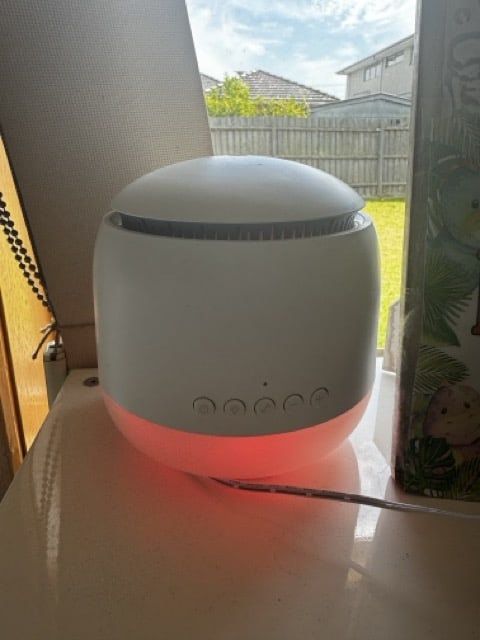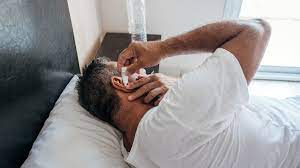How to Fall Asleep Quickly Even When You’re Not Tired
Or shift work tools page has a lot more information about blue light and some great videos explaining what blue light blockers do in more detail.
If you need a visual, here is what they look like. We have a couple of different pairs we alternate between.
Swanwick Sleep, also has a yellow almost clear lens you will find online. These are more “computer glasses” that won’t help you sleep but will take away some of the glare from the screen by limiting the blue light. I did a video comparison which you can watch below.
2. Listen to Soft or “Colored” Tunes
Tossing and turning while your mind races at 3 AM? Don’t underestimate the power of sound!
Both music and white noise tap into our brain’s sleep-inducing mechanisms, even when we’re not physically drained. According to the Sleep Foundation, music works its magic by lowering stress hormones and releasing calming dopamine, creating a peaceful mental space. There is a reason they use binaural beats in day spas…
Calming melodies and slow tempos guide your brainwave activity towards sleep, while upbeat music can distract from intrusive thoughts, allowing your mind to unwind.
White noise, on the other hand, acts as a sound barrier, masking disruptive environmental noises and preventing them from jolting you awake. Its consistent, neutral sound provides a comforting backdrop, similar to the womb’s constant hum, fostering a sense of security and relaxation.
Remember, not all sounds are created equal. Experiment with different genres, tempos, and white noise variations to find your personal sleep soundtrack. So, the next time your brain won’t shut down, try turning up the volume on slumber – you might be surprised at how quickly the Sandman arrives!
Here is a link to one of my favourite playlist on spotify. Though don’t be afraid to try brown or green noise too!
We recently published a post about the most relaxing tunes to help you sleep. It has a bunch of video and playlist examples for you to try out.
3. Put on Your Yoga Tights Before Bed
Yoga has been proven to decrease stress and tension by encouraging the practice of calm and deep breathing patterns.
My personal favorite way to practice yoga on the cheap is streaming it via YouTube to my TV via my Chromcast I bought on Amazon (ad). One of these days I’ll buy a smart TV but for now this works just fine.
My go-to channel is ‘Yoga with Adrienne’ and it’s what I recommend. She’s beautifully calm, educational and easy to follow.
Here is a great relaxing video to help you wind down and feel tired before bed.
- Child’s Pose (Balasana)
- Cat-Cow Pose (Marjaryasana-Bitilasana)
- Thread the Needle Pose (Paschimottanasana)
- Legs-Up-the-Wall Pose (Viparita Karani)
- Supported Bridge Pose (Setu Bandha Sarvangasana)
- Reclining Hero Pose (Supta Virasana)
- Corpse Pose (Savasana)
- Listen to your body and modify any poses as needed. Don’t push yourself into pain.
- Create a relaxing atmosphere before you begin your practice. Dim the lights, turn off electronic devices, and play calming music.
- Focus on your breath and release any tension you hold in your body.
- Be patient and consistent. It may take some time to see the benefits of yoga for sleep.
Our final exercise tip is, if you don’t experience negative effects with vigorous exercise shortly before bed, this could be the perfect solution to sleep as you’ll have tired yourself out. However, for me, I found it has the opposite effect. I talk a lot about exercising before bed and weather it’s a good idea here. Sleep or Workout? What Should I Do After Night Shift? I made a video about it too which you can watch below.
4. Use Lavender and Aromatherapy
The calming scent of lavender can be your key to slumberland. Studies, such as this one and this one, suggest it interacts with the nervous system, promoting relaxation and reducing anxiety, both of which can hinder sleep. According to Dr. Axe, It’s a powerful essential oil that has been shown to improve symptoms of PTSD, support brain function, reduce stress and help us sleep.
Incorporate aromatherapy into your bedtime routine:
- Diffuse: Add a few drops of lavender essential oil to a diffuser, filling your room with its soothing aroma.
- Spritz: Create a DIY pillow mist by combining water, witch hazel, and a few drops of lavender oil in a spray bottle. Spritz lightly on your pillow before sleep.
- Soak: Draw a warm bath with Epsom salts and a few drops of lavender oil. Immerse yourself and let the scent and warmth melt away stress.
- Snuggle: Place a sachet filled with dried lavender near your pillow, allowing its gentle fragrance to lull you into sleep.
Remember, aromatherapy works best alongside healthy sleep habits like a consistent sleep schedule, a relaxing bedtime routine, and a sleep-conducive environment. Sweet dreams!
This lavender oil pictured is very popular on Amazon and well worth a sniff. We use it in our diffuser pictured but it will work perfectly well in the suggestions we gave above. Here is a link to another popular diffuser via Amazon. (ad)
5. Write Down What’s Stressing You Out
open next page to continue reading….





